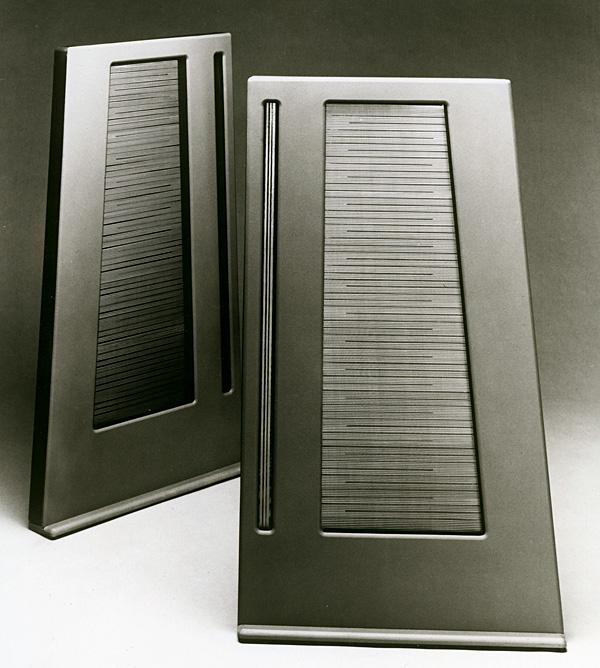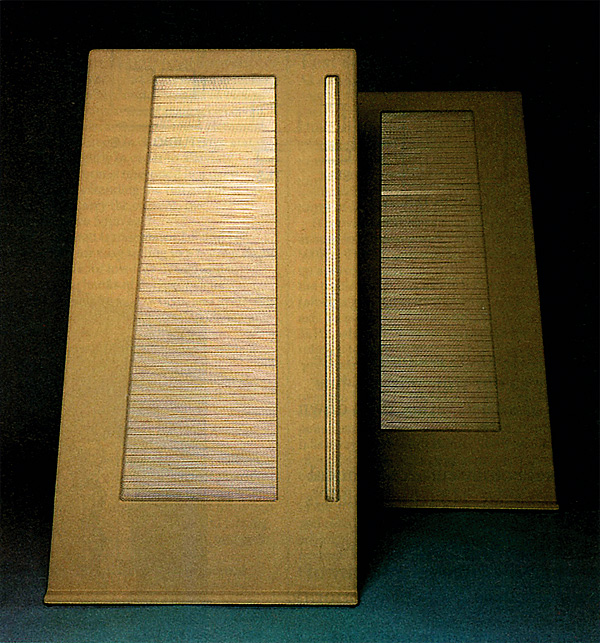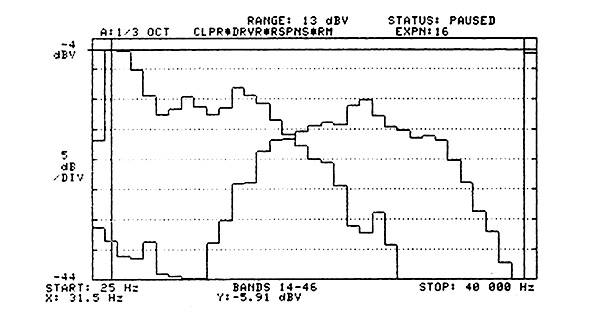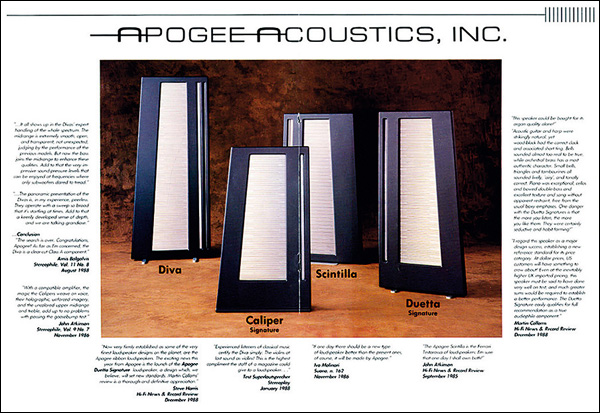High Caliper

 With the latest Apogee, ribbon technology comes in a more affordable package. Ken Kessler's assessment follows Martin Colloms' review
With the latest Apogee, ribbon technology comes in a more affordable package. Ken Kessler's assessment follows Martin Colloms' review
The US company Apogee has expanded its range of open-panel loudspeakers, which began with the Apogee model itself. This was a large-scale design using three separate diaphragms, with pure aluminium ribbons for frequencies above a few hundred Hertz. Three other models are now in production, comprising, in descending order of size and price, the Scintilla [HFN Sep '85], Duetta, and now the so-called 'baby' of the group, the £2500 Caliper.
Kapton Kids
Some baby this, for each speaker weighs a substantial 35kg and ideally two persons are required to manhandle it out of its package and install the feet. Once set up, you are not going to move it very often!

Given that the big Apogee is priced at close to £10,000, the Scintilla at the £5000 level, with the simpler Duetta at £3000, the Caliper, some hundreds of pounds cheaper, finds itself in competition with two other US models: the Magneplanar 11 and MartinLogan CLS. It's hard to think of a direct UK equivalent, though the KEF R107 and Celestion System 6000 are both roughly in this territory, as of course is the active Linn Isobarik.
The Caliper and Duetta (as the latter's name implies) are two-way speakers whereas the larger models are both three-way. Finally, the bigger speakers both use pure aluminium ribbons, but the individual ribbon conductor of the Duetta and Caliper are attached to a larger and heavier Kapton foil film substrate, comprising a plastic that's resistant to high temperature.
While I have no reservations concerning the subjective acoustic transparency of the pure aluminium ribbon, I have yet to be fully convinced by the metal/plastic composite as used in the mid/treble section of both these more affordable Apogee models.

Cruise Control
The Scintilla was distinguished by its breathtaking inefficiency: 80-81dB/8ohm/1W in the 1ohm mode (the true power input is 8W for this output). The Duetta and Caliper are much improved in real terms in that a normal impedance is offered. That said, the voltage sensitivity is still low, at typically 80dB/1W for a 2.83V (8ohm-watt) input.
Rated as a 'budget' model by its makers, the Caliper is not, as was first rumoured, suitable for use with modest amplifiers. While 150W will gently floor the bass diaphragm on heavy rock bass, it sounds weak on powers up to 50W, and 150W/channel (8ohms rating) is really required to help it cruise. For the economy-minded, the Counterpoint SA12 II, also from the UK Apogee agent, Absolute Sounds, could be worth investigating, but at present my vote would probably go to the promising Musical Fidelity P270. Both these amplifier models offer the required power headroom.
All Apogee's loudspeakers employ a heavy open panel construction and hence are bi-directional, with a back-wave sound virtually as strong as that radiated from the front. Consequently, they need very careful placement, clear of reflective rear walls, and often give of their best situated one third of the way down a long room.


The contoured frame is constructed from MDF material, sprayed matt in either taupe (a light beige) or charcoal (a dark grey). The largest diaphragm covers the bass to lower-midrange and comprises a composite aluminium foil and Kapton film structure. It is horizontally pleated for stiffening, in order to resist bending modes about the vertical axis, which is the most likely form in view of its drive method and geometry.
Another Apogee feature is the semi-trapezoidal shape of both the complete panel and, more particularly, the woofer section. By strongly tapering one side, the higher mode rectangular panel resonances are largely dispersed. As with the larger Apogee models, the diaphragm is not integrally self-supporting. A special suspension is fitted, allowing for differential tuning of the fundamental resonance of the upper and lower sections of the radiating element, thus smoothing and extending the response.
Bar Exam
Magnetic energisation comes from an array of large ferrite bar-magnets, aligned horizontally and covering the main central area, but not following the taper. At 93cm tall, the bass section tapers from 29cm wide at the base to 20cm at the top, and allowing for baffling the effective radiating area is 2000cm2, with a fairly generous excursion of 7.6mm before severe overload. (Think of the output of three long-throw 12in diameter moving-coil woofers per channel!) The drive current flows in a series of horizontal zig-zags directed by precision-cut slits in the diaphragm foil, achieving a sensible overall impedance.

Second Driver
As for the magnets, these are supported on a heavy steel backplate, extensively perforated to help reduce reflections. Given the gap spacing, any reflections that remain should be well above the operating range of the main diaphragm, whose output is rolling away by 1kHz (sound wavelength 30cm). Uniformly but single-sided driven over virtually its entire area, the bass element should be essentially free from breakup, which is a weakness of most designs that are driven from a single point, eg, the voice coils of cone loudspeakers.
The second driver, covering the mid/treble, is a Kapton film element approximately 30mm wide by 94cm high, fitted with a foam wedge at the rear to angle the resulting two elements slightly in order to alleviate directionality in the vertical plane. The ribbon is tensioned in a deep vertical slot flanked by open bar-magnets extending the full height of the speaker. Three parallel aluminium strips carry the current, one approximately 6mm wide and the other two 5mm each.
The system comes bi-wired with separated terminals for LF and HF sections, but shorting straps are supplied for easy setting to a normal single terminal pair. The crossover is very simple, of low-loss design and using the highest quality components, including banks of polypropylene capacitors for the treble section. The slopes are 6dB/octave, and given the time-aligned nature of the system, considerable driver overlap occurs and is indeed encouraged to fill out the response.


















































